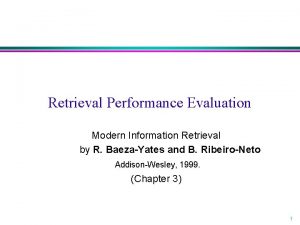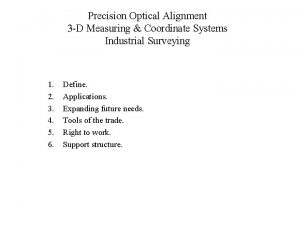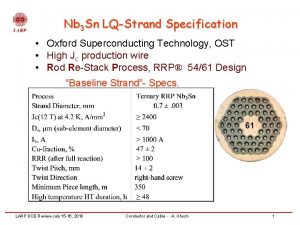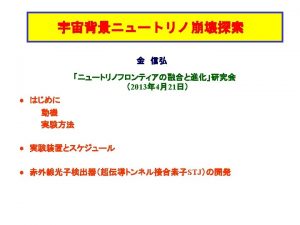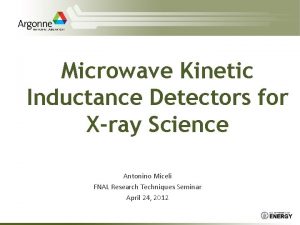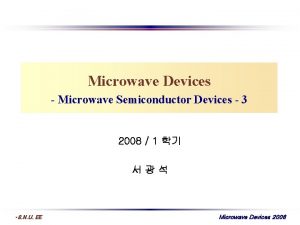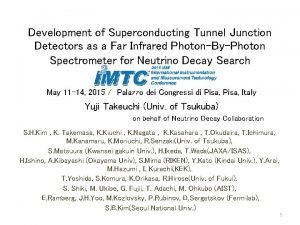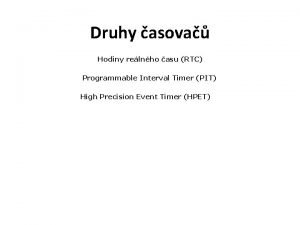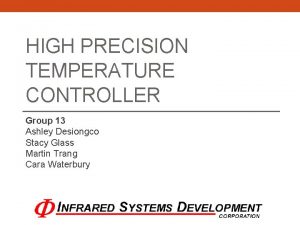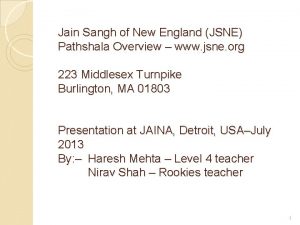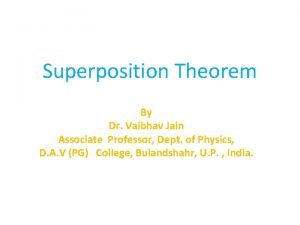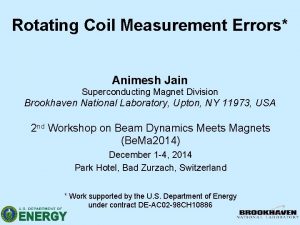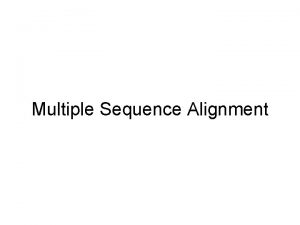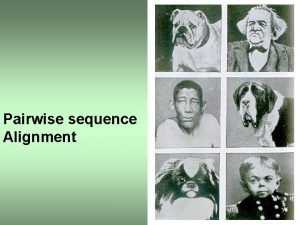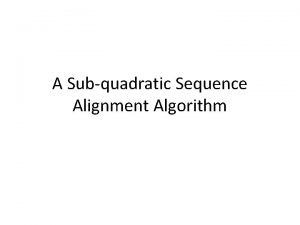High Precision Alignment of Multipoles Animesh Jain Superconducting










































- Slides: 42

High Precision Alignment of Multipoles* Animesh Jain Superconducting Magnet Division Brookhaven National Laboratory, Upton, NY 11973 Low Emittance Rings 2010 Workshop (LER 2010) CERN, Geneva, Switzerland, 12 -15 January, 2010 * Work supported by the U. S. Department of Energy under contract DE-AC 02 -98 CH 10886 High Precision Alignment of Multipoles: Animesh Jain, BNL LER 2010: January 12 -15, 2010

Acknowledgements M. Anerella, R. Ceruti, J. Cintorino, T. Dilgen, S. Dimaiuta, L. Doom, J. Escallier, G. Ganetis, P. He, R. Hubbard, P. Joshi, F. Karl, P. Kovach, F. Lincoln, W. Louie, A. Marone, J. Mc Caffrey, D. Oldham, S. Ozaki, S. Plate, P. Ribaudo, A. Sauerwald, S. Sharma, J. Skaritka, C. Spataro, D. Sullivan, P. Wanderer, F. Willeke D. Harder, G. Rakowsky, NSLS Alexander Temnykh, Cornell University L. Rivkin, D. George, Swiss Light Source Dieter Einfeld, Montse Pont, ALBA High Precision Alignment of Multipoles: Animesh Jain, BNL LER 2010: January 12 -15, 2010 1

NSLS-II Lattice and Magnets • Standard Quadrupole (66 mm): • Normal Sextupole: • Type A: Single coil, short, 11 T/m Stability requirements: • Type A: Symmetric, 68 mm • Type B: single coil, wide, 11 T/m Dipole: 25 ppm rms Type B: Wide, 68 mm Δp/p<5 x 10 -5 • Type C: Double Coil, long, 22 • T/m • Type D: Doulbe Coil, short, 22 • Large T/m Aperture: 76 mm Quadrupole: 50 ppm • Type E: Double Coil, Wide, 22 • All T/msextupoles have Peak to peak beta beat <0. 5% 2 maximum strength of 400 T/m • Large Aperture: 90 mm, 15 T/m and peak to peak tune jitter <1 x 10 -3 Courtesy: Weiming Guo, NSLS-II, BNL. Sextupole: 100 ppm Alignment Specifications: 100 mm girder to girder; 30 mm magnet to girder; ± 0. 2 mrad magnet roll High Precision Alignment of Multipoles: Animesh Jain, BNL LER 2010: January 12 -15, 2010 2

Introduction • For optimum performance, the magnetic axes of quadrupoles and sextupoles in NSLS-II should be aligned to better than ± 30 microns. • It is difficult to achieve the required accuracy using magnet fiducialization, coupled with optical survey. • It is difficult, and expensive, to maintain the required machining and assembly tolerances in a long support structure (~5 m) holding several magnets. • It is desirable to achieve the required alignment using direct magnetic measurements in a string of magnets. • The vibrating wire technique, developed at Cornell, was deemed to be the most appropriate for this task. High Precision Alignment of Multipoles: Animesh Jain, BNL LER 2010: January 12 -15, 2010 3

Steps Involved in Alignment • Determine magnetic axis of all elements on a girder. • Move magnets on a girder to a common axis. • Secure magnets to the girder without disturbing the alignment. • Verify alignment after securing the magnets. • Fully characterize the magnet and girder positions in space. • Reproduce the magnet and girder positions during the final installation in the machine. High Precision Alignment of Multipoles: Animesh Jain, BNL LER 2010: January 12 -15, 2010 4

Magnet Alignment R&D • Although the vibrating wire technique had been used in the past for quadrupole measurements, very little work had been done in sextupoles. • An R&D program was initiated to further develop the technique at BNL and demonstrate the required accuracy for both quadrupoles and sextupoles. • Good measurement reproducibility has been achieved as a result of several improvements made over the course of this R&D program, which started in January, 2007. • Work is still underway to study alignment stability and to adapt the measurements for a production environment. High Precision Alignment of Multipoles: Animesh Jain, BNL LER 2010: January 12 -15, 2010 5

The Vibrating Wire Technique: Basics • An AC current is passed through a wire stretched axially in the magnet. • Any transverse field at the wire location exerts a periodic force on the wire, thus exciting vibrations. • The vibrations are enhanced if the driving frequency is close to one of the resonant frequencies, giving high sensitivity. • The vibration amplitudes are studied as a function of wire offset to determine the transverse field profile, from which the magnetic axis can be derived. High Precision Alignment of Multipoles: Animesh Jain, BNL LER 2010: January 12 -15, 2010 6

Salient Features of the Vibrating Wire System • Aerotech ATS 03005 stages for wire movement (0. 1 micron resolution; 2. 5 micron/25 mm accuracy). • Wire ends are defined by stainless steel V-notches. • Set of 7 fiducials at each end to locate the V-notches. • A pair of X-Y wire vibration sensors at each end of the wire. Allows two independent, simultaneous measurements for data verification and redundancy. • Completely rewritten acquisition and analysis software with scripting support for flexibility in experiment control. High Precision Alignment of Multipoles: Animesh Jain, BNL LER 2010: January 12 -15, 2010 7

Wire End Support (V-notch) Fiducial nests (7) Stainle ss Vnotch Holes to help locate the notch relative to fiducials Fiducials relate the wire ends to the overall girder coordinate system. A V-notch with radius much smaller than the wire was chosen. The wire position is thus insensitive to the actual radius of the V-notch. High Precision Alignment of Multipoles: Animesh Jain, BNL LER 2010: January 12 -15, 2010 8

Wire Vibration Sensors Coarse manual adjustment in The wire motion sensors orthogonal are inexpensive axis photointerrupters (Model GP 1 S 094 HCZ 0 F) A pair of sensors is located on both ends of Y-Sensor the wire, thus allowing two simultaneou s measureme nts. Fine, automated adjustment along measurement As wire is moved axisthe using horizontally piezo stages or X-Sensor vertically, the position of the wire relative to the sensor changes slightly (~ a few microns) due to imperfections in the stage motion. This causes a change in the operating point of the sensor. An automated piezo stage was added to the wire High Precision Alignment of Multipoles: Animesh Jain, keep BNL LER 2010: January 12 -15, 2010 “centered” in the 9

Complete Wire Mover Assembly Camera to ensure wire is correctly seated in the notch A similar assembly is present at the other end of the wire, except that the pulley and weight are replaced by a fixed wire end. Light Shades to reduce noise from stray light V-notch holder with fiducials High Precision Alignment of Multipoles: Animesh Jain, BNL LER 2010: January 12 -15, 2010 10

Alignment Issues Studied • • Wire sag correction Detector sensitivity to orthogonal motion Sensitivity to Yaw/Pitch of magnets Accuracy of quadrupole center measurement Accuracy of sextupole center measurement Background field correction Ability to precisely move magnets (manually) and secure to the girder. • Reproducibility of the girder vertical profile. • Stability of magnet alignment after transporting a girder. High Precision Alignment of Multipoles: Animesh Jain, BNL LER 2010: January 12 -15, 2010 11

Detector Sensitivity to Orthogonal Motion Measured signal is contaminated by sensitivity to motion along the orthogonal axis, thus causing errors in the measurement of magnetic center. A rigorous analysis has shown that the error in horizontal/vertical center is minimized if wire is scanned at the vertical/horizontal center in both quadrupoles and sextupoles. This implies that a rough center must be found first before. High the. Precision final. Alignment scan. of Multipoles: Animesh Jain, BNL LER 2010: January 12 -15, 2010 12

Resonant Mode to Use: Yaw/Pitch Sensitivity • Should have a maxima near the axial center of the magnet being measured. • Preferably even numbered modes should be used to avoid contribution from any axially uniform background fields (e. g. earth’s field). • It may be impractical to find a mode with maxima exactly at the axial center for every magnet on the girder. This causes sensitivity to yaw and pitch. • One should choose a mode that minimizes sensitivity to yaw and pitch without sacrificing signal strength. High Precision Alignment of Multipoles: Animesh Jain, BNL LER 2010: January 12 -15, 2010 13

Sensitivity to Yaw and Pitch Signal for mode = n is proportional to Byn (for a given detector position) In a quadrupole magnet with offset x 0 and yaw angle Q, located at z = zmag: zmag = magnet axial position; G = Gradient Lmag = magnetic length L = wire length Error in center determination due to yaw: A similar expression applies to vertical offset and pitch angle. A similar analysis for sextupoles is much more tedious, but the same expression for Dx 0 is obtained in the end! High Precision Alignment of Multipoles: Animesh Jain, BNL LER 2010: January 12 -15, 2010 14

Yaw/Pitch Sensitivity for Various Modes High Precision Alignment of Multipoles: Animesh Jain, BNL LER 2010: January 12 -15, 2010 15

Reproducibility of Horizontal Center in Quad High Precision Alignment of Multipoles: Animesh Jain, BNL LER 2010: January 12 -15, 2010 16

Reproducibility of Vertical Center in Quad Temperature stabilized environment is required ! High Precision Alignment of Multipoles: Animesh Jain, BNL LER 2010: January 12 -15, 2010 17

Sextupole Measurements Using By and Bx • Obtaining centers from By vs. x and By vs. y plots uses only one set of sensors, and requires quadratic fits. • One could also use scans of Bx vs. x (or y) for various values of y (or x). These plots are expected to be linear with slopes proportional to offsets in y (or x) direction. • Doing three such scans allows to obtain centers from both Bx and By data. With 2 sets of sensors, one gets four values of magnetic center. High Precision Alignment of Multipoles: Animesh Jain, BNL LER 2010: January 12 -15, 2010 18

Sextupole Measurements: By Scans Parabolic fits High Precision Alignment of Multipoles: Animesh Jain, BNL LER 2010: January 12 -15, 2010 19

Sextupole Measurements: Bx Scans High Precision Alignment of Multipoles: Animesh Jain, BNL LER 2010: January 12 -15, 2010 20

Yet Another Way to Measure Sextupoles Fit measured data to a truncated Fourier Series, giving quadrupole and sextupole terms. Both X and Y Centers can be obtained using any of the 4 detectors in a single scan. High Precision Alignment of Multipoles: Animesh Jain, BNL LER 2010: January 12 -15, 2010 21

Comparison of Sextupole Data Using Bx and By High Precision Alignment of Multipoles: Animesh Jain, BNL LER 2010: January 12 -15, 2010 22

Issue of Background Fields in Sextupole Meas. • There is a significant quadrupole background field from quadrupole magnet(s) even when these are unpowered. • Based on rotating coil data, the remnant integrated quadrupole field is ~0. 02 T. This could amount to a change in horizontal center by hundreds of microns, depending on quad position and the mode used for sextupole measurements. • The vertical center measurement is not affected because By (or Bx) is independent of y (or x) in a quadrupole field. • Effectiveness of background correction has been tested by measuring a sextupole in the presence of a quadrupole which was either unpowered, or was powered at 2 A (apparent center shift of ~600 microns). Corrected center = ± 5 microns. High Precision Alignment of Multipoles: Animesh Jain, BNL LER 2010: January 12 -15, 2010 23

Reproducing Girder Vertical Profile • The girder, if supported at the four corners only, has a sag of about 150 microns. • Based on studies done in a prototype girder, the vertical profile of the girder could vary by as much as ~30 microns simply as a result of handling. • It is, therefore, essential to not only measure the magnet centers precisely, but also to have a precise means of characterizing and then reproducing the girder vertical profile during installation. • It was demonstrated that the girder vertical profile can be measured to better than ~10 microns using multiple laser tracker setups in a temperature controlled chamber (< ± 0. 1 C). High Precision Alignment of Multipoles: Animesh Jain, BNL LER 2010: January 12 -15, 2010 24

Feasibility of Profiling by Laser Tracker A Laser Tracker target was placed on an adjustable mount and its vertical position was monitored with a digital dial gauge. The laser tracker was used to measure changes in the vertical position and the results were compared to the dial gauge readings. Typical agreements were well below 10 microns. High Precision Alignment of Multipoles: Animesh Jain, BNL LER 2010: January 12 -15, 2010 25

NSLS-II Prototypes in Vibrating Wire Test Stand High Precision Alignment of Multipoles: Animesh Jain, BNL LER 2010: January 12 -15, 2010 26

Alignment Stability • Four NSLS-II prototype quadrupole magnets were mounted on a prototype girder, and prealigned using a laser system. • The girder was installed in the temperature controlled room and the magnets were hooked up to power and water supplies. • The magnetic centers of all the magnets were measured, and all the remaining steps in the alignment process outlined earlier were carried out. • The girder was then removed from the test bench, loaded on a truck, driven around the laboratory site, unloaded and reloaded on the truck, and then brought back to the test area. • The girder was reinstalled, the girder vertical profile was reproduced using survey, and magnetic centers were measured again to see if the initial alignment of the magnets was maintained. High Precision Alignment of Multipoles: Animesh Jain, BNL LER 2010: January 12 -15, 2010 27

Alignment Stability During Girder Handling Four NSLS-II Prototype Quadrupoles on a Prototype Girder High Precision Alignment of Multipoles: Animesh Jain, BNL LER 2010: January 12 -15, 2010 28

Conclusions • An extensive R&D program has been carried out to build a state-of-the -art vibrating wire system, and to study various issues. • Possible sources of error are studied analytically, and the measurement procedures developed to minimize the errors. • Excellent consistency (at sub-micron level) is routinely achieved between data from two sets of sensors. • Absolute accuracy of < 5 mm, as judged by correlation with mechanical motion, and consistency between four independent methods of measuring a sextupole, has been demonstrated. • It has been shown that magnets can be secured to the girder while maintaining alignment within ~ 5 mm. • The alignment of the magnets was shown to survive careful handling. • The vibrating wire system is nearly ready for production measurements. High Precision Alignment of Multipoles: Animesh Jain, BNL LER 2010: January 12 -15, 2010 29

Thank You ! High Precision Alignment of Multipoles: Animesh Jain, BNL LER 2010: January 12 -15, 2010 30

Supplemental Material High Precision Alignment of Multipoles: Animesh Jain, BNL LER 2010: January 12 -15, 2010 31

Resonant Frequency and Wire Sag T = Tension L = Length = mass per unit length Mode = 6 ~7. 3 m long, 0. 125 mm dia. Cu-Be wire; 1. 05 Kg weight High Precision Alignment of Multipoles: Animesh Jain, BNL LER 2010: January 12 -15, 2010 32 Correction for large wire sag (~550 -600 microns for ~7. 3 m length) is very important, which in turn requires a very precise knowlege of resonant frequency. ± 0. 02 Hz Þ ± 1 micron

Experimental Setup for Sag Measurements Wire Dial indicator A vertical wire sensor is mounted on a vertical stage and is placed at axial center of the wire. For a given weight, the sensor is adjusted until zero signal is obtained, and the resonance frequency is measured. A dial indicator is used to monitor change in detector position (or sag) with weight. Sensor High Precision Alignment of Multipoles: Animesh Jain, BNL LER 2010: January 12 -15, 2010 33

Sag: Measured Vs. Calculated Dial indicator accuracy is ± 3 mm High Precision Alignment of Multipoles: Animesh Jain, BNL LER 2010: January 12 -15, 2010 34

Stability of Wire Sag Over Several Days SLS Quadrupole SLS Sextupole Resonant frequency, and hence sag, is continuously derived as part of the measurements. Thus stability is strictly needed only at time scale of ~1 hour. High Precision Alignment of Multipoles: Animesh Jain, BNL LER 2010: January 12 -15, 2010 35

Horizontal Scans (Bx): Slope Vs. Y Offset From d. Bx/dx Vs y Plots: YCenter(1) = -0. 0306 mm YCenter(2) = -0. 0304 mm High Precision Alignment of Multipoles: Animesh Jain, BNL LER 2010: January 12 -15, 2010 36

Vertical Scans (Bx): Slope Vs. X Offset From d. Bx/dy Vs x Plots: XCenter(1) = -0. 0100 mm XCenter(2) = -0. 0094 mm High Precision Alignment of Multipoles: Animesh Jain, BNL LER 2010: January 12 -15, 2010 37

Horizontal Center Reproducibility in Sextupole High Precision Alignment of Multipoles: Animesh Jain, BNL LER 2010: January 12 -15, 2010 38

Procedure for Multipole Alignment on a Girder • Install magnets on a girder, install vacuum chamber, and carry out a rough alignment using a laser system (horizontal and vertical offsets, pitch and yaw) and inclinometers (roll). • Set up girder on a vibrating wire test stand in a temperature controlled environment (± 0. 1 C), and wait for steady state. • Tighten the 4 corner studs on the girder to several hundred ft-lbs, secure center bolts and tighten to ~ 100 ft-lbs. • Power one magnet at a time and measure the magnetic center using vibrating wire technique in the vibrating wire coordinate system, including appropriate correction for wire sag. • Repeat for all magnets on the girder. High Precision Alignment of Multipoles: Animesh Jain, BNL LER 2010: January 12 -15, 2010 39

Procedure for Alignment on a Girder (contd. ) • Force all displacement gauges to display the corresponding measured magnet offsets. • Lock the magnets in place, while monitoring the magnet positions to bring the magnets on-axis by making all gauges to read zero again. • If required, carry out vibrating wire measurements again to confirm alignment. • Survey the wire ends, and all girder and magnet fiducials using laser trackers. In particular, measure the girder vertical profile precisely (better than ± 10 microns). • Disconnect and remove the girder from the test stand. High Precision Alignment of Multipoles: Animesh Jain, BNL LER 2010: January 12 -15, 2010 40

High Precision Alignment of Multipoles: Animesh Jain, BNL LER 2010: January 12 -15, 2010 41
 Electric multipoles
Electric multipoles High precision vs high recall
High precision vs high recall High precision vs high recall
High precision vs high recall Significant figures
Significant figures Global alignment example
Global alignment example Jonathan pevsner
Jonathan pevsner Dna substitution
Dna substitution Global alignment vs local alignment
Global alignment vs local alignment Bioinformatics sequence alignment
Bioinformatics sequence alignment Precision optical alignment equipment
Precision optical alignment equipment Semi-precision attachment
Semi-precision attachment Negatif sayıların binary gösterimi
Negatif sayıların binary gösterimi Non precision instrument
Non precision instrument Superconducting
Superconducting Oxford superconducting technology
Oxford superconducting technology Superconducting tunnel junction
Superconducting tunnel junction Mkid
Mkid Pascal febvre
Pascal febvre Superconducting ring
Superconducting ring Superconducting tunnel junction
Superconducting tunnel junction Western superconducting
Western superconducting Superconducting devices in quantum optics
Superconducting devices in quantum optics Superconducting tunnel junction
Superconducting tunnel junction Stj
Stj High precision 이벤트 타이머
High precision 이벤트 타이머 Dsp block
Dsp block Pid
Pid High precision capacitors
High precision capacitors Rajeev jain md
Rajeev jain md Preet jain
Preet jain Conclusion of jainism
Conclusion of jainism Jsne
Jsne Anu jain
Anu jain Prateek jain msr
Prateek jain msr Temple
Temple Jain way of life
Jain way of life Meru rajju
Meru rajju Vaibhav.14v
Vaibhav.14v Jain society of central florida
Jain society of central florida Jain portal
Jain portal Jain bcn
Jain bcn Vinod jain ca
Vinod jain ca Vidya jain case
Vidya jain case

